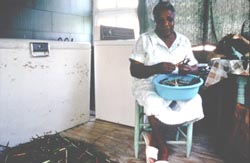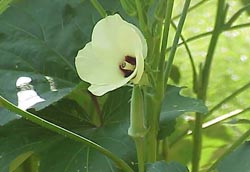Louisiana Cooking: A Way of Life
By Ulysses S. Ricard
To the average person, Louisiana evokes images of meandering bayous, oaks draped with Spanish moss, and lacy, wrought iron balconies in the Vieux Carré (French Quarter) of romantic New Orleans. In much the same way, Louisiana cooking evokes many images—images of potent and savory gumbos, "exotic" dishes of crawfish or alligator, and sweet Creole pralines. However, just as Louisiana is more than just bayous and the Vieux Carré, cooking in Louisiana is more than just the piquant dishes of South Louisiana.
Louisiana is a marvelous amalgam of different peoples and cultures. To the indigenous inhabitants of the state, the native Americans, were added people from many different racial, cultural and linguistic backgrounds. The eighteenth century witnessed the arrival of the French (from France, French Canada, or the French colonies of the Caribbean), Africans, (the institution of slavery was introduced during the earliest days of the colony), Germans (who were rapidly assimilated into the predominant Latin culture), Spaniards (from Spain, the Canary Islands, or the Spanish colonies of the New World), and Acadians (whose descendants would later come to be popularly called "Cajuns"). With the exception of a small area around Natchitoches in North Louisiana, these groups settled primarily in south and Southwest Louisiana.
Louisiana was sold to the United States in 1803 and large numbers of English speaking settlers of Anglo-Saxon/Scotch-Irish descent from eastern and southern states started making their way to the newly acquired territory. The majority of these new Louisianians made their home in northern, western, and southeastern sections of the state.
The cultural and linguistic differences between French-speaking Latin South Louisiana and English-speaking Anglo-Saxon North Louisiana—which are so very noticeable even to the present day—can be traced back to those early settlement patterns. Louisiana cooking reflects these two very different cultural traditions both in tastes and methods of preparation.
The cooking of North Louisiana was inherited from those English speaking settlers. The variety of dishes which are prepared in the northern section of the state are very similar to those which can be found in other southern states of the United States. Thus, we find in North Louisiana cornbreads, biscuits, chicken and dumplings, greens, black-eyed peas and other dishes which we consider to be so typical of southern cooking. Canning is also very popular and a wide variety of fruits and vegetables are used—blackberries, mayhaws, peppers, cucumbers, etc. Though these dishes are not as highly seasoned as those in the southern section of the state, they are still very tasty.
Seafood, though not as common in North Louisiana as it is in the south, is still prepared quite frequently. The most popular seafood dish in North Louisiana is probably fried catfish (both fresh water and pond raised) and north Louisianians have elevated its preparation to haute cuisine.
However, it is the Creole and Cajun cooking of the southern section of the state for which Louisiana is so famous. These two styles of cooking have become so well known nationally and internationally that people automatically think of great cooking when Louisiana is mentioned. But, what is Creole and Cajun cooking? These two very similar cooking styles evolved in New Orleans and South Louisiana and are a combination of the cooking styles of all the different groups who have lived in South Louisiana. To the French taste for fine cuisine and elegant sauces were added the Spanish use of seasonings and rice dishes (Louisiana's jambalayas are variations of the Spanish paellas). African foodstuffs such as okra, German sausages (andouille, for example), and the American Indian use of herbs such as filé (ground sassafras leaves).
Many people wonder what are the differences between Creole and Cajun cooking. It is at times impossible to say whether a particular dish is Creole or Cajun; they share many of the same influences. For example, both Creole and Cajun cooks prepare gumbos, jambalayas, etouffees and many other dishes too numerous to mention. But, what distinguishes a Creole jambalaya from a Cajun jambalaya; or, a Creole gumbo from a Cajun gumbo? Probably no one can answer that question, for every pot of gumbo is unlike every previous pot. No two cooks prepare gumbo the same way and no two cooks use the same ingredients or the same quantities. However, it is important to remember that the basic preparations are the same. Many years ago, before travel communication improvements were made, there probably was a difference between Creole and Cajun cooking; but these differences, if they still exist, are disappearing. Thus, it was possible at one time to differentiate them by saying that Creole cooking was urban and Cajun cooking was rural. However, the urban/rural difference is now quite blurred.
Several of the more salient characteristics of Creole and Cajun cuisine are the use of spices and seasoning (especially peppers and herbs), the use of rice prepared as a main dish or as a side dish (as in jambalaya); and the use of a roux as a basis for the soups and gravies for which South Louisiana is famous. This is a mixture of flour and oil (or lard) which is cooked, while being stirred constantly, until the flour turns a nice caramel brown. The roux is essential for many of the most famous dishes of New Orleans and South Louisiana.
There is a great variety of dishes in Creole and Cajun cuisine. Some of the more typical ones are: jambalaya, a rice and meat and/or seafood dish similar to a paella; gumbo, a thick soup made of okra (the word gumbo comes from the African word for okra, guingombo), poultry and/or seafood; filé gumbo, a non-okra type gumbo which uses as a thickener filé, ground leaves of the sassafras tree; crawfish etouffee, a stew served over rice; turtle sauce piquante, turtle meat cooked in a very hot and tangy sauce; and pralines, a type of sugar and pecan candy. This is only a small sample of Creole and Cajun cuisine.
Other national groups—besides those already mentioned—have influenced Louisiana cooking and each has contributed to the large number of dishes one can find in the state. For example, Italian influence can be seen in the pasta, eggplant and artichoke dishes which are so popular in South Louisiana. The influence of Italian cuisine cannot be overlooked.
The influence of the many peoples and cultures that came to Louisiana, the cooking traditions and methods of these people, the natural richness of Louisiana's soil, and its abundant supply of seafood have all had a part in creating the native culinary richness that Louisiana offers and that cannot be matched in any other state or region in the United States.







